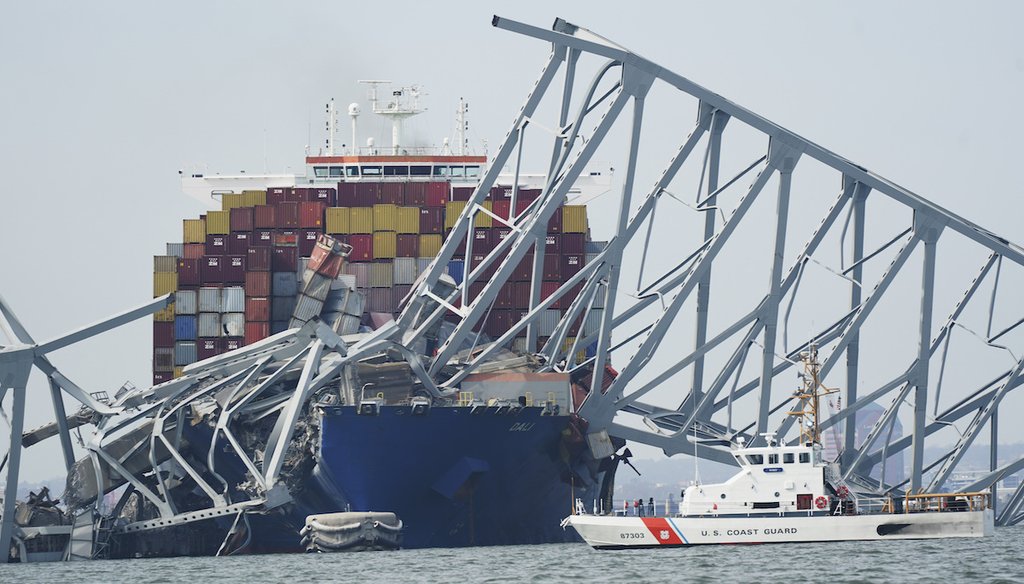

Our only agenda is to publish the truth so you can be an informed participant in democracy.
We need your help.


A Coast Guard cutter passes a cargo ship that is stuck under the part of the structure of the Francis Scott Key Bridge March 26, 2024, in Baltimore, Md. (AP)
The National Transportation Safety Board used the Dali’s voyage data recorder, which collected audio and sensor data from the ship, to build a rough timeline of events preceding the March 26 bridge collapse.
At about 1:25 a.m., the recorder briefly stopped logging the ship’s sensor data, which includes the ship’s speed, engine rotations per minute, rudder angle and heading. However, audio recordings continued.
Sensor data recording resumed about a minute later. A few minutes afterward, the ship crashed into Baltimore’s Francis Scott Key Bridge.
Social media users are claiming a recording device on the Dali was intentionally stopped before the cargo ship collided with the Francis Scott Key Bridge in Baltimore. But this is misleading.
A March 28 Instagram post shared a Fox News report in which a National Transportation Safety Board official detailed the events preceding the March 26 bridge collapse. In the video, the official says the ship’s sensor data ceased recording for about a minute before the collision.
Text on the video read, "Nothing to see here! Black box on ship stops recording right before crash, then turns back on right after."
The post’s caption said, "They are hoping you will not notice this."
(Screengrab from Instagram)
This post was flagged as part of Meta’s efforts to combat false news and misinformation on its News Feed. (Read more about our partnership with Meta, which owns Facebook and Instagram.)
The pause in sensor data recording before the bridge collision is still under investigation.
The post mischaracterizes what the National Transportation Safety Board, an independent federal agency, said about recorded data from the ship. During a March 27 briefing, officials from the National Transportation Safety Board, which is leading the investigation into the bridge collapse, gave the timeline of events preceding the bridge collapse based on preliminary data from the ship’s voyage data recorder, or VDR.
The Instagram post called this device the ship’s "black box," which is a term sometimes used to describe an aircraft’s flight recorder. But voyage data recorders provide fewer data points than flight data recorders, National Transportation Safety Board Chair Jennifer Homendy said. Voyage data recorders are "basic" and show "a snapshot of the major systems on a vessel," she said.
The Dali’s voyage data recorder includes audio recordings and information about ship speed, engine rotations per minute, rudder angle, ship heading and alarms, the National Transportation Safety Board said.
Based on this information, the agency said the Dali left the Port of Baltimore at 12:39 a.m. and entered the Fort McHenry Channel about 30 minutes later, traveling at about 9 miles per hour.
Then, at about 1:25 a.m., "numerous audible alarms were recorded on the ship’s bridge audio. About the same time, VDR sensor data ceased recording. However, the VDR audio continued to record using the redundant power source," National Transportation Safety Board Chief Investigator Marcel Muise said at the March 27 briefing.
About a minute later, at 1:26 a.m., "the VDR resumed recording sensor data," Muise said.
Then, the National Transportation Safety Board said the ship’s pilot made steering commands and ordered the anchor to be dropped. At about 1:27 a.m., the pilot made a mayday call and said the Dali had lost power and was approaching the bridge. The agency is investigating what caused the ship’s power loss.
At 1:29 a.m., audio recordings reported sounds consistent with the bridge collision. And, a few seconds later, the pilot reported the Key Bridge was down, the National Transportation Safety Board said.
Based on this timeline, the Dali’s voyage data recorder briefly stopped recording sensor data, but not audio, about four minutes before the ship crashed into the bridge. The outage lasted for about a minute. Officials said the voyage data recorder was working when the collision occurred.
We rate the claim that the ship’s "black box" stopped recording "right before (the) crash" then turned back on "right after" False.
RELATED: Baltimore bridge collapse: A cyberattack, a movie and other false claims about the ship accident
Instagram post (archived), March 28, 2024
YouTube, "NTSB Media Briefing 2 - Francis Scott Key Bridge struck by Cargo Ship Dali," March 27, 2024
National Transportation Safety Board Newsroom, X post, March 27, 2024
National Transportation Safety Board Newsroom, X post, March 27, 2024
National Transportation Safety Board Newsroom, X post, March 27, 2024
National Transportation Safety Board Newsroom, X post, March 27, 2024
National Transportation Safety Board Newsroom, X post, March 27, 2024
Merriam-Webster Dictionary, "black box definition," accessed April 1, 2024
CNN, "What we know about the Baltimore bridge collapse," March 29, 2024
The Associated Press, "Baltimore Key bridge collapse live updates: Two bodies recovered, authorities say," March 27, 2024
PolitiFact, "Baltimore bridge collapse: A cyberattack, a movie and other false claims about the ship accident," March 27, 2024
In a world of wild talk and fake news, help us stand up for the facts.
